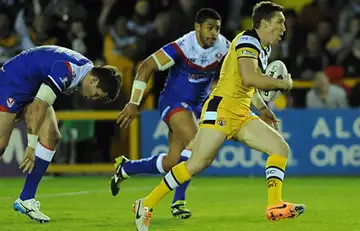Obstruction objection

It’s nothing new for the rugby league community to be left scratching its collective head over what does or doesn’t constitute an obstruction.
The latest bout of confusion stems from Saturday’s Challenge Cup quarter final between Wigan and Castleford which saw a number of obstruction decisions.
The two key moments came either side of the half-hour mark. On 28 minutes Luke Dorn saw a try ruled out by video referee Ben Thaler for obstruction. However, on 31 minutes a strikingly similar incident in the lead up to James Clare’s opener was referred by Richard Silverwood but given the green light by Thaler.
In the first decision Weller Hauraki was ruled to have obstructed George Williams as Liam Finn’s cut-out pass found Dorn. Castleford’s supporters, and others, were flummoxed, as Williams was nowhere near being able to effect a tackle on Dorn.
I found something else confusing, however. My understanding had always been that obstruction was only given in these circumstance when the player in possession – Finn – travelled behind the dummy runner – Hauraki – using him as a shield. This didn’t happen – Finn released the ball to Dorn without travelling behind Hauraki.
I could accept I had been wrong in my understanding if it wasn’t that Thaler displayed the very same understanding three minutes later in awarding Clare’s try. Despite a clear collision with Sean O’Loughlin, Thaler decided there had been no obstruction because: “he’s not run behind the man … it’s not obstruction.”
The RFL rules aren’t clear on obstruction. They give examples of what does and doesn’t constitute obstruction, but these all involve two players, while the most common incidents are when a third player – a dummy runner – is penalised.
The rules and everyone’s understanding of them need to be tightened up, because nobody really understands the difference between Clare’s try and Dorn’s disallowed try, and because clever attacking play may continue to be penalised needlessly.
—
Bradford Bulls have failed in their appeal against their six-point deduction for going into administration. An independent panel today ruled that the deduction would stand, leaving Bradford still second-from-bottom in the Super League table and in serious danger of relegation.
The Bulls are currently considering what options are available to launch another appeal against this latest decision. However, it’s questionable whether this is the best course of action to take. Will it be helpful for the club to embark on another lengthy appeals process – especially when the likely result will be another confirmation of the four-point deduction?
The case for Bradford hasn’t been made publicly, but the independent panel clearly didn’t think there was any case to answer. That being the case it’s hard to see any circumstance now in which the Bulls would receive back all or some of their deducted points.
—
The venues for the Challenge Cup semi finals have been announced, with Leeds playing Warrington at St Helens and Castleford facing Widnes at Leigh.
Predictably the announcement has led to anger and complaints from fans on Twitter and Facebook. A typical complaint has been that neither semi takes place in Yorkshire, with both games taking place in the North West.
However, this is to overlook that the majority of Challenge Cup semi finals in the summer era have been held in Yorkshire, including two occasions when both semis have been staged at Huddersfield.
In the last ten years St Helens have had to travel to Huddersfield to play Leeds three times, so it’s hardly unfair now for Leeds to have to travel to St Helens to face Warrington.
I personally blame London Broncos for all this.
Keep Your Eye on Rugby League
Twitter: @Tony_Williams88